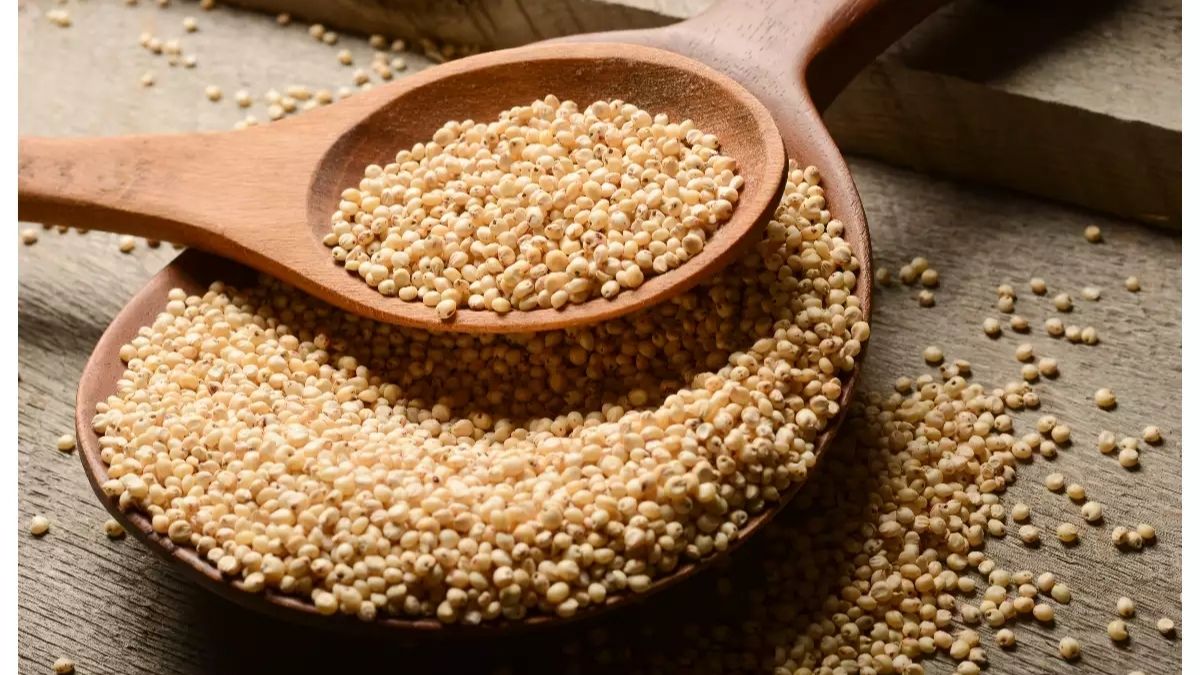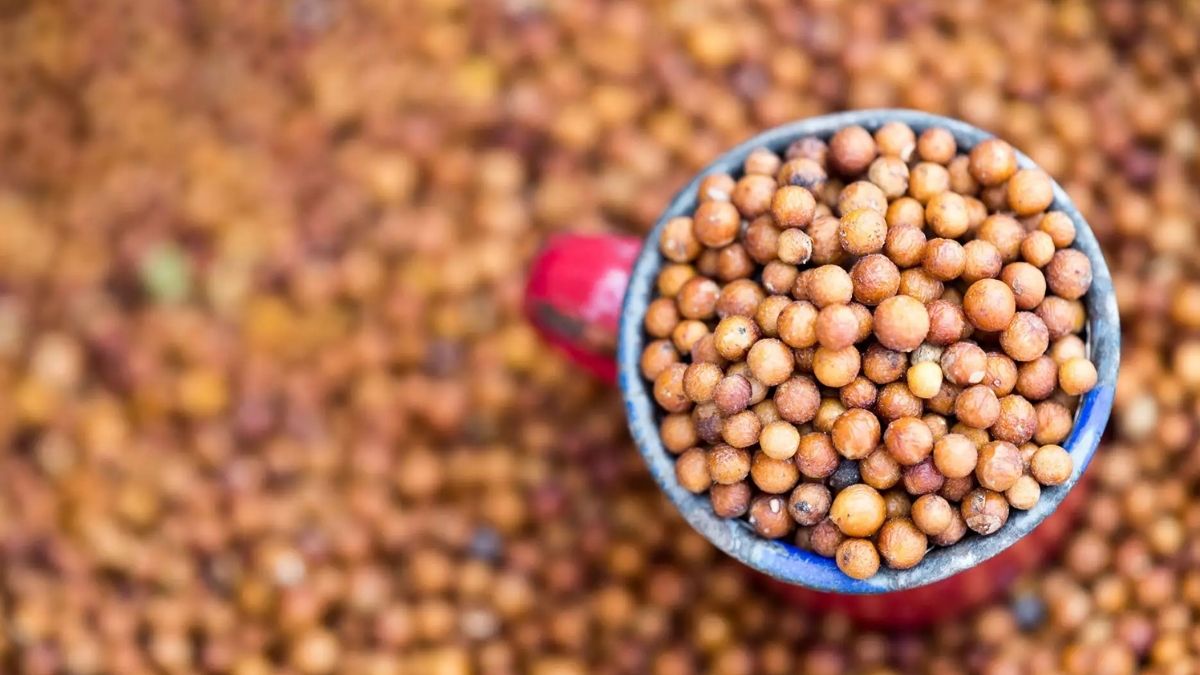Sorghum flour is gluten-free with a mild, sweet flavor and smooth texture. It is frequently used in combination with other gluten-free flours to create gluten-free cakes, bread, and other baked items.
The sorghum grain comes from the grass family (Poaceae) and has been grown as a crop for almost 8,000 years. Sorghum comes in many forms: whole grain, pearled grain, popped, syrup, bran, flakes, and flour. Grain sorghum has seed stalks in white, yellow, red, deep purple, and brown, as well as a leafy stalk that looks like corn. Sorghum is a versatile cereal grain that can be eaten by people and used to feed animals, make alcoholic drinks, and make biofuels. Sorghum is a good source of fiber and antioxidants when eaten with the outer hull still on.
What is Sorghum Flour?
Sorghum is a cereal grain, and most flour is made from Sorghum bicolor, also known as jowar flour. When made into flour, Sorghum has a mild, slightly sweet taste and a smooth texture that makes it great for making brownies, cookies, muffins, waffles, and many other baked goods. The texture and density of sorghum flour are the same as those of all-purpose wheat flour. It is interesting because it helps keep water in the dough or batter and helps CO2 bubbles form when making bread. Sorghum flour is beige and has a soft, slightly clumpy texture, but it mixes well with other flours when whisked together. Not only does it work well in baked goods, but it also makes a tasty, crispy coating for fried foods.
Sorghum is an African grain that has been around for a long time in the United States. However, until recently, it was thought that only animals could eat it. What used to be added to animal feed is now being used more and more in cereal, muffins, and bread instead of or along with wheat flour. Sorghum flour also called milo flour and jowar atta, is welcome in pantries worldwide because it is high in protein, iron, and fiber and doesn’t contain gluten.
Some gluten flour substitutes, like rice flour, can make cookies or bread feel grainy. Bakers like the smoother texture of Sorghum. Since nothing in the world is perfect, the trade-off is that sorghum flour can make liquid disappear. It’s drier than Uncle Bob’s sense of humor, James Bond’s martinis, and the pile of bones where a penitent who walked across the Atacama Desert to get rid of his sins is buried. People with celiac disease can’t digest gluten protein found in oats, wheat, and barley. With Sorghum, they don’t have to give up their pancakes or toast. Even people who can eat gluten are asking for baked goods made with Sorghum because it has more protein, fiber, and fewer calories than white flour.
How to Cook Sorghum?
Sorghum is a versatile grain that can be cooked on the stove, in a slow cooker, or the oven, among other ways. Like rice, I’ll show you how to cook it on the stove.
Sorghum:
We will begin with 1 cup of dried Sorghum.
Water or Broth:
We need 3 cups of liquid for every cup of Sorghum. Either water or broth can be used.
Salt:
Finally, you’ll want to use a pinch of salt to flavor things.
Cook the Sorghum:
Put the Sorghum and water (or broth) in a big pot to start. Add a lot of salt to the pot if you are using water. Please bring it to a boil, then turn it down to a slow boil. Cook for 45 to 60 minutes with the lid on.
Let it Rest:
After cooking, let the Sorghum sit for 5 minutes with the lid on. Remove any extra water from the pot and fluff the rice with a fork. Add salt to your taste.
Ingredients
- 1 cup sorghum 180 g
- 3 cups water or broth 708 mL
- Pinch of salt
Nutrition Information
Serving: 1cup cooked (¼ uncooked) Calories: 170kcal (9%) Carbohydrates: 36g (12%) Protein: 4g (8%) Fat: 0.5g (1%) Saturated Fat: 0g Cholesterol: 0mg Sodium: 0mg Potassium: 165mg (5%) Fiber: 8g (33%) Sugar: 0g Calcium: 6mg (1%) Iron: 2mg (11%)
How to Use Sorghum in your Home Cooking?
3 Ways to Use Sorghum in Your Home Cooking
1. Sorghum Syrup
“Sweet sorghum” is a type of Sorghum whose stalks have more sugar than other types. It is used to make a sweetener called “sorghum molasses.” In the southern part of the United States, biscuits are served for breakfast with tangy-sweet sorghum syrup. You can also put it on pancakes, grits, and other hot cereals.
2. Sorghum Flour
Sorghum flour, made from ground grain sorghum, can be used in many recipes, especially those that call for whole wheat flour. Sorghum flour is great for making gluten-free flatbreads like injera, short pieces of bread, muffins, pasta, and desserts. (When xanthan gum is added to sorghum flour, it gives it more structure and power.) Gluten-free oat flour is the closest substitute for sorghum flour, but quinoa flour or brown rice flour can also work, depending on the recipe.
3. Whole Grain Sorghum
In some parts of the world, Sorghum is cooked like couscous and used as the base for grain bowls and other dishes. Whole grain sorghum goes well with raw, steamed, or roasted vegetables and a light dressing. Like oats, sorghum kernels can be cooked on the stove or in a slow cooker to make a breakfast porridge topped with various things.
Where does Sorghum Come from?
Sorghum bicolor, also called “broomcorn,” was first tamed about 8,000 years ago in Ethiopia and Sudan. Now, you can find different sorghum crops worldwide, in Asia, Australia, North America, and Africa. Since Sorghum is grown from hybrid seeds, it is not genetically modified and can grow in dry conditions.
Sorghum grows best in dry places. In the U.S., the “sorghum belt” stretches from South Dakota through Nebraska and Kansas to South Texas. Traditionally, Sorghum was grown in the United States to feed animals. However, this has changed recently as people with Celiac disease have become more interested in this gluten-free grain.
What does Sorghum Flour Taste Like?
Sorghum flour isn’t eaten by itself. The flavor of foods made with it comes from the other ingredients, like yeast, sugar, salt, fats, and so on, as well as the caramelization of starches that happens when the dough or batter is cooked. If you tasted the flour, it would be bland, dry, and powdery. Instead of wheat flour, you can use sorghum flour, which doesn’t have gluten. It works well in bread and muffins, but the earthy taste of Sorghum makes it hard to use in cakes and other sweet treats.
It has more nutrients than corn and is high in protein and fiber. The neutral taste of the flour makes it a good substitute for wheat in some recipes. It also doesn’t make things as dense or heavy as most gluten-free flours do. This is a great choice for people with celiac disease who don’t want to eat gluten-free foods but don’t want to give up flavor. The taste of sorghum flour depends on the type of grain that was used to make it. White Sorghum tastes sweet, while dark Sorghum tastes nutty.
How to Store Sorghum?
Don’t dry Sorghum in thick layers because the top layers could grow mold. Sorghum that will be stored for a year should be dried down to less than 12 percent moisture.
Like other grains, Sorghum can be stored for a long time. It can also be cooked, frozen, and reheated later, which is great for having almost ready meals.
Uncooked: Store uncooked sorghum grains in the pantry in a sealed, airtight container. They will stay fresh for about four months.
Cooked: The cooked Sorghum should be kept in the fridge and eaten within a few days. If you freeze it, eat it within six months.
Is Sorghum Flour Gluten-Free?
Yes, but it can’t be used alone to replace wheat flour like most gluten-free flours can’t. But it is often combined with other gluten-free flours in recipes to make all kinds of baked goods taste great. Many gluten-free flour mixes, like Bob’s Red Mill Gluten-Free 1:1 Baking Flour, have sorghum flour as one of their ingredients. Gluten is not in Sorghum; Sorghum doesn’t have gluten and is a great alternative to grains. It is a whole grain with many vitamins and minerals and has protein, iron, and other vitamins and minerals than the popular quinoa.
Potential Health Benefits of Sorghum
The structure of Sorghum is different, which makes it harder for your body to absorb proteins from the whole grains. Even though this is a problem, studies have shown that eating Sorghum is good for your health in some ways.
Anti-Inflammatory Effects
People know that Sorghum has a lot of phenolic compounds, many of which are antioxidants. Due to its antioxidant properties, have also been shown to be good at reducing some types of inflammation.
Anti-Cancer Effects
Several phenolic compounds of Sorghumhaves been linked to anti-cancer effects. Tannins, which give Sorghum its color, may stop an enzyme-linked to breast cancer growth from working. 3-Deoxyanthocyanidins are another group of phenolic compounds found in Sorghum, and these compounds have been shown to kill some human cancer cells.
Weight Loss
Compared to other grains, Sorghum’s starches are hard for the body to break down. Because of this, Sorghum is a great addition to any meal because it makes you feel full without adding too many calories.
Safe for Celiac Disease
People with Celiac disease can eat Sorghum and its products, like sorghum flour, without worrying about getting sick.
Potential Health Risks of Sorghum
The biggest health risk of Sorghum is tied to its potential as an allergen.
There are a lot of people who have allergies to grasses and grass pollen. Sorghum is a grass, and the grass is known to make some people have allergic reactions. Some signs of a food allergy are tingling or itching, swelling in and around the mouth, stomach pain, feeling sick, throwing up, or even passing out. Any food allergy can cause a severe allergic reaction called anaphylaxis, which can kill you.
Conclusion
Sorghum, also called milo, is an old grain that tastes mild and earthy, like wheat berries. The sustainable gluten-free grain is a versatile ingredient that chefs use in many ways. You can find sorghum flour in the health food or alternative baking sections of many of the bigger grocery stores. If you see a product called “sweet white sorghum flour,” that’s what you want, even though the product itself isn’t sweet. Or it could be called just “sorghum flour.” It’s also available online. Sorghum flour can be kept for 3 to 4 months in a cool, dry place, like a pantry, as long as the package is closed tight. If you live in a warm, humid place, you can also put it in the fridge in a bag that won’t let any air in.

